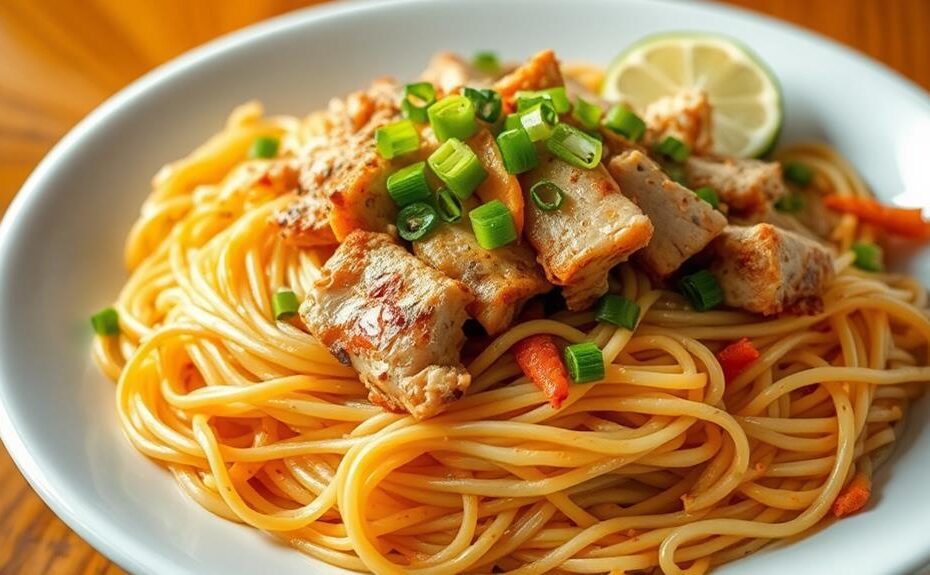Step 1: Prepare the Noodles
Soak rice noodles in warm water for 15-20 minutes to achieve the perfect texture.
Step 2: Make the Chicken Broth
Use bone-in chicken thighs and aromatics like onion scraps to prepare a flavorful chicken broth.
Step 3: Sauté Aromatics
Sauté garlic and onions to create an aromatic base for the dish.
Step 4: Add Colorful Vegetables
Add colorful vegetables to the sautéed mix for added flavor and texture.
Step 5: Combine the Broth and Sautéed Mix
Combine the chicken broth with the sautéed mix, ensuring all the flavors are well incorporated.
Step 6: Add Noodles and Shredded Chicken
Add the soaked noodles and shredded chicken to the broth mixture, stirring well to combine.
Step 7: Season to Taste
Season the dish with salt, pepper, and other desired seasonings to achieve the perfect flavor balance.
Step 8: Garnish with Fresh Herbs
Garnish the dish with fresh herbs, such as green onions or parsley, for added freshness and flavor.
Step 9: Serve
Serve the Chicken Pancit Bihon hot, straight from the wok or pot.
Step 10: Master the Dish
Mastering this Filipino classic requires practice and experimentation to discover the nuances that make it truly unforgettable.
Soak Rice Noodles in Water
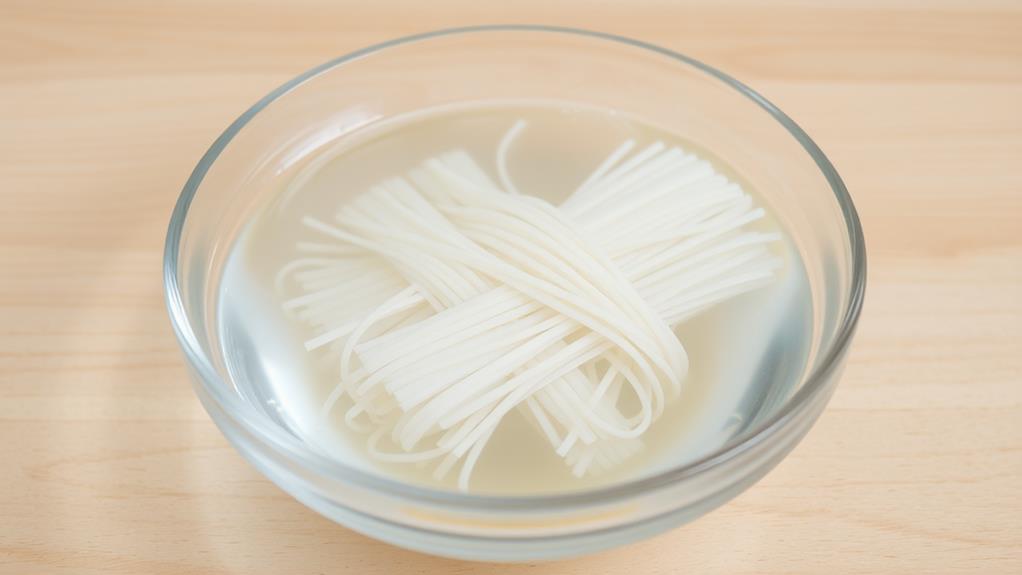
Soaking rice noodles in warm water is essential for preparing them for stir-fry. This step softens the noodles, making them pliable for easy stir-frying. It's crucial to soak them for 15-20 minutes to achieve the right texture.
Using boiling water can make the noodles too soft and mushy, so it's best to use warm water. During soaking, the noodles absorb water, which helps them cook evenly and enhances their texture in the final dish.
After soaking, drain the noodles and gently separate them to prevent clumping during cooking. This step is vital, as over-soaking can lead to a loss of the noodles' delicate structure, resulting in an undesirable consistency when combined with other ingredients.
Correct soaking ensures perfectly cooked noodles with a great texture. This makes all the difference in your stir-fry, ensuring a flavorful and enjoyable dish.
Prepare Flavorful Chicken Broth
Create a Flavorful Chicken Broth for Pancit Bihon
To prepare a rich and savory foundation for Pancit Bihon, you need a flavorful and nutritious chicken broth. You can choose from two methods to create this broth: pressure cooker or stovetop.
Pressure Cooker Method
This method is fast and convenient, allowing for quick extraction of flavors.
Stovetop Method
This method has a slower cooking time, ideal for developing rich and deep flavors.
To prepare the broth, use 1.75 lbs (795g) of bone-in chicken thighs and simmer them in 5 cups of water with kosher salt for enhanced taste.
Add vegetable trimmings like onion scraps and carrot peels to increase the broth's depth and nutritional value.
After cooking, strain the broth to remove solids and reserve the shredded chicken for later use in the Pancit Bihon dish.
Adjust the seasoning with salt, coconut aminos, or fish sauce to achieve your desired flavor profile.
This flavorful chicken broth will serve as the base of your Pancit Bihon, providing a rich and savory flavor that complements the noodles and other ingredients.
Sauté Garlic and Onions in Oil
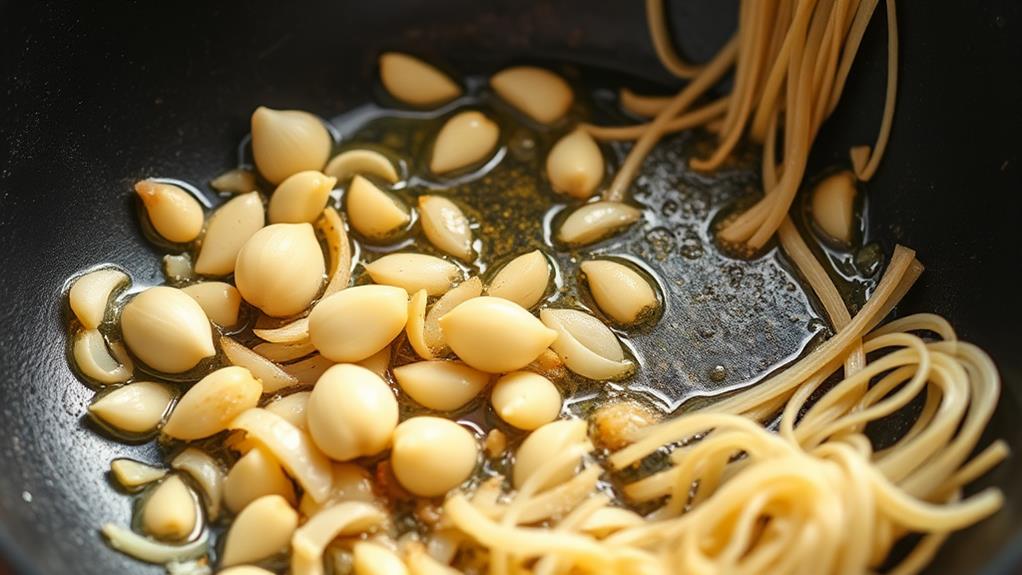
Creating an Aromatic Base for Chicken Pancit Bihon
To elevate the flavor profile of your Chicken Pancit Bihon, you need to create an aromatic base by sautéing garlic and onions in oil. This crucial step requires attention to detail to achieve the right balance of flavors.
Sautéing Garlic
To sauté garlic correctly, use medium heat to prevent burning, which can impart a bitter taste to the dish. Finely mince the garlic to ensure even cooking and distribution throughout the pancit.
Sauté the garlic in oil until it turns golden brown and fragrant, which typically takes about 1-2 minutes.
Sautéing Onions
After sautéing the garlic, add diced onions and cook until they're translucent, which usually takes about 3-5 minutes. This allows their natural sweetness to develop, adding depth to the flavor profile.
By sautéing garlic and onions in oil, you'll create an aromatic base that will enhance the overall flavor of your Chicken Pancit Bihon.
Add Julienned Vegetables to Mix
Add Color, Texture, and Flavor with Julienned Vegetables
Adding julienned vegetables to your Chicken Pancit Bihon brings color, texture, and flavor to the dish. To ensure even cooking and prevent sogginess, aim for uniform thickness when preparing the vegetables.
Choosing the Right Vegetables and Cooking Times
| Vegetable | Thickness | Cooking Time |
|---|---|---|
| Carrots | Thin strips | 2-3 minutes |
| Bell Peppers | Thin slices | 2-3 minutes |
| Snow Peas | Whole or halved | 1-2 minutes |
Sautéing for Freshness
Briefly sautéing the vegetables keeps them vibrant and crisp. Cook them just until tender to maintain their freshness. Common vegetable choices for Pancit Bihon include snow peas, green beans, and red onion, which complement the dish's flavor profile.
Absorbing Flavors
As you add the julienned vegetables to the mix, they'll absorb the flavors of the sautéed garlic and onions, setting the stage for the next step. By incorporating these vegetables into the stir-fry process, you'll enhance the overall taste of the dish, which will eventually be elevated by the flavorful broth.
Introduce Broth to Sautéed Mix
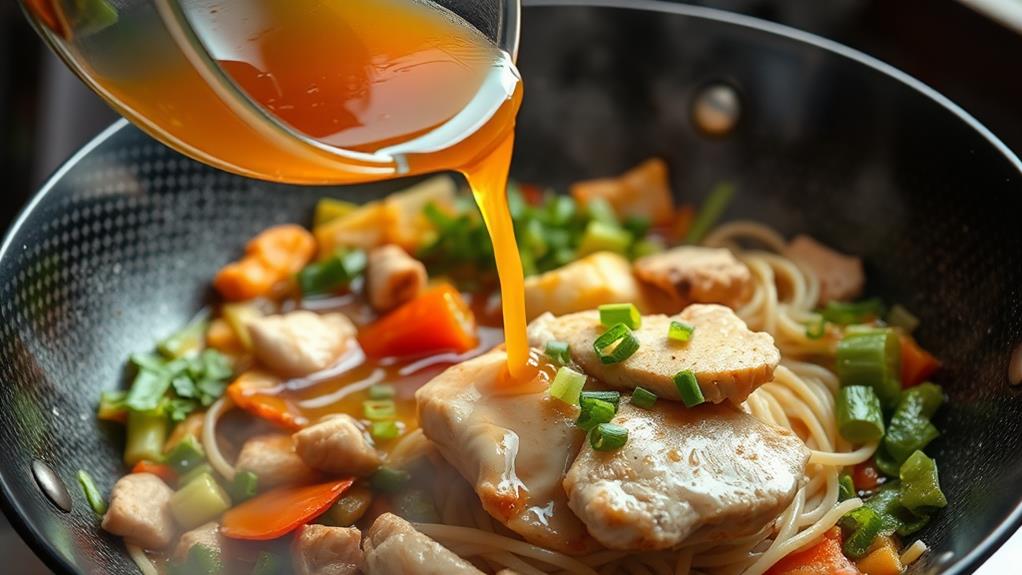
Introduce Broth to Sautéed Mix
Now that your sautéed mix of onions, garlic, and vegetables is ready, it's time to add the homemade chicken broth. Strain the broth to remove any solids, ensuring a smooth liquid base for your dish.
Gradually introduce the strained broth to the sautéed mix in the pan, allowing the flavors to meld together.
Bring the broth and sautéed mixture to a boil, which enhances the aroma and depth of flavor in the dish. This step is critical, as it sets the stage for the noodles to absorb the rich chicken broth and seasoning.
Stir continuously as you bring the mixture to a boil, evenly distributing the broth among the vegetables and preparing the pan for the noodles.
With the broth and sautéed mix combined, you're one step closer to creating a flavorful and savory Chicken Pancit Bihon.
Add Soaked Noodles to Absorb Flavors
Soaked Noodles Absorb Flavors Effectively
After soaking bihon noodles in warm water for 15-20 minutes, they become pliable and ready to absorb flavors.
Adding them to the pan after introducing the homemade chicken broth allows the noodles to soak up the flavors effectively. Gently stir the noodles into the mixture to ensure even distribution of flavors and prevent clumping.
Soaking Enhances Flavor Absorption
The soaking process helps noodles cook evenly and enhances their ability to absorb rich tastes from sautéed vegetables and proteins.
Allow the noodles to simmer briefly in the broth, enabling them to fully absorb moisture and seasoning.
Distribute the noodles evenly throughout the pan, ensuring each strand is coated with the savory broth and seasonings. This creates a harmonious balance of flavors and textures in the final dish.
Incorporate Shredded Chicken and Seasonings
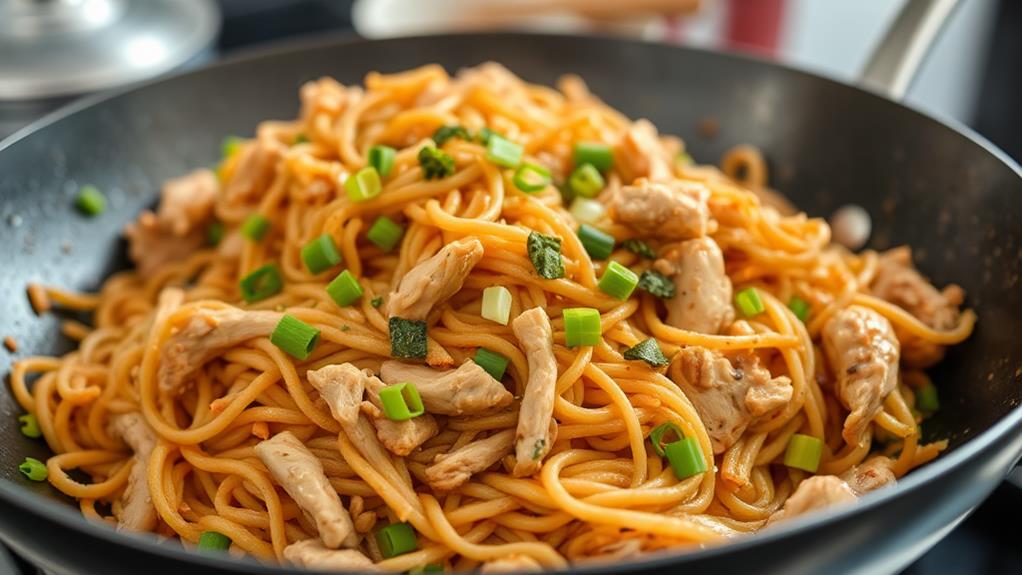
Incorporating Shredded Chicken and Seasonings
With the noodles absorbing the flavors of the homemade chicken broth, it's time to add the protein component to the dish. Shred the boiled chicken into bite-sized pieces to ensure even distribution throughout the dish and allow each bite to be packed with flavor.
Sauté the shredded chicken in the pan after cooking the vegetables to enhance its flavor and allow it to absorb the seasonings. Common seasonings such as soy sauce and fish sauce can be incorporated during the cooking process, adjusting to taste for a balanced flavor profile.
Mix the shredded chicken thoroughly with the soaked noodles and vegetables to ensure each ingredient is coated with the seasonings, maximizing flavor in every bite. This creates a harmonious blend of flavors that will elevate your cook pancit to the next level.
Remember to reserve the chicken broth created from boiling the chicken, as it serves as a flavorful base when combined with the noodles.
Garnish With Fresh Herbs and Serve
Garnish with Fresh Herbs and Serve
A few finishing touches can elevate your Chicken Pancit Bihon from a satisfying meal to a visually appealing and flavorful masterpiece.
Garnishing Options
Freshly chopped green onions add a pop of color and a mild onion flavor that complements the dish.
Cilantro or parsley provide a vibrant green touch and a refreshing herbal note that enhances the overall taste.
A sprinkle of fried garlic gives a crunchy texture and an aromatic, savory flavor, elevating the dish's appeal.
Serving Suggestions
Serve with a side of lemon wedges or calamansi, allowing your guests to squeeze fresh juice over their portion for an added zing of acidity.
Thinly sliced red chili peppers can be added as a garnish for those who enjoy a bit of heat in their meal.
Pair With Filipino Favorites for Complete Meal
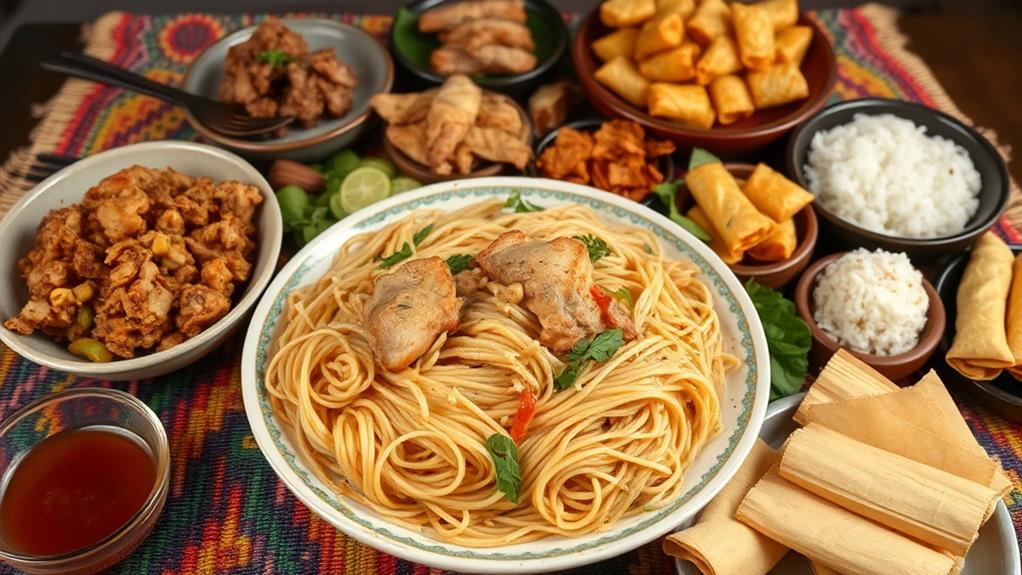
Transforming Chicken Pancit Bihon into a Well-Rounded Filipino Feast
To create a complete meal, pair Chicken Pancit Bihon with complementary dishes that enhance its flavors and textures.
Serving it with lumpia, crispy spring rolls filled with vegetables or meat, creates a delightful contrast in textures and flavors.
For a quick and easy addition, pair your pancit dish with Filipino pork barbecue skewers, marinated in a sweet and savory sauce, to complement the savory notes of the pancit.
Including a side of ensalada, a fresh salad made with tomatoes, onions, and cucumbers, adds a refreshing element to the meal.
If you want to add more richness, pair it with a side of adobo, a popular Filipino dish made with marinated meat cooked in vinegar and soy sauce, enhancing the overall flavor profile.
Finish the meal with a dessert like leche flan, a creamy caramel custard that provides a sweet ending to the savory dishes enjoyed together.
Are the Steps in the Quick Guide for Chicken Pancit Bihon the Same as the Easy Steps?
Yes, the steps in the quick guide for the easy chicken pancit bihon recipe are the same as the easy steps. Whether you follow the quick guide or the easy steps, you’ll be able to make a delicious and satisfying chicken pancit bihon dish in no time.
Store Leftovers Properly for Later Enjoyment
Proper Storage Maintains Flavor and Texture
Proper storage is essential to preserving the flavor and texture of Chicken Pancit Bihon. Store leftover Chicken Pancit Bihon in an airtight container in the refrigerator for up to 4 days to maintain freshness and prevent spoilage.
For longer storage, freeze Chicken Pancit Bihon in a freezer-safe container, where it can last for up to 3 months without significant loss of quality.
Labeling Containers Ensures Safe Consumption
Always label containers with the date of storage to keep track of freshness and ensure safe consumption within recommended timeframes. This helps you identify how long the leftovers have been stored and whether they're still safe to eat.
Reheating Preserves Texture and Flavor
When reheating, gently warm the dish in a skillet or microwave to preserve the texture of the rice noodles and prevent them from becoming mushy.
If you've frozen your Chicken Pancit Bihon, thaw it in the refrigerator overnight before reheating to ensure even warming and maintain flavor integrity.
Frequently Asked Questions
How Do You Cook Pancit Canton Steps?
Step 1: Cook the Noodles
Cook pancit canton noodles in boiling water until they're al dente, which typically takes 3-5 minutes.
Step 2: Prepare the Aromatics
Heat oil in a pan and sauté minced garlic and onion until fragrant.
Step 3: Add Protein and Vegetables
Add diced protein such as chicken and cook until browned.
Then, stir-fry thinly sliced veggies like carrots and bell peppers until they're tender.
Step 4: Combine and Season
Toss cooked noodles with the sautéed ingredients and add soy sauce to taste.
Stir-fry for 2-3 minutes to meld the flavors together.
What Is the English Name for Bihon?
Rice noodles is the English name for Bihon.
Bihon refers to thin rice vermicelli noodles commonly used in Filipino dishes like Pancit Bihon. They've a rich history influenced by Chinese cuisine and are made from rice flour and water, making them gluten-free.
These noodles are known for their light texture and ability to absorb flavors well.
For example, in Pancit Bihon, the noodles absorb the savory flavors of the vegetables and seasonings.
How to Cook Super Q Bihon?
Soften the Rice Noodles: When cooking Super Q Bihon, start by softening the rice noodles in warm water.
Create a Flavorful Base: Then, sauté garlic and onion to create a flavorful base.
Add Protein and Veggies: Add your protein of choice, such as chicken or shrimp, and cook until done.
Next, stir-fry in julienned veggies like carrots and bell peppers.
Combine Noodles with Seasonings: Finally, combine the noodles with soy sauce and seasonings, tossing to coat.
Customize to Taste: This bihon preparation allows for flavor enhancements through ingredient variations.
Serving Suggestions: Serving suggestions include garnishing with green onions and lime for a fresh finish.
What Is the Difference Between Pancit Bihon and Pancit Guisado?
Pancit Bihon and Pancit Guisado are two distinct pancit variations with notable differences.
Pancit Bihon is made with rice vermicelli noodles, which gives it a lighter, more delicate texture and a straightforward flavor profile. This is because rice vermicelli noodles have a neutral flavor and a soft, fragile texture.
In contrast, Pancit Guisado can include various noodle types, such as rice flour noodles, egg noodles, or a combination of these. This variety of noodles contributes to a heavier, richer flavor. Additionally, Pancit Guisado often features a diverse range of ingredients and sauces, which further enhance its flavor profile.
Regional recipes and cooking techniques also set Pancit Bihon and Pancit Guisado apart.
Pancit Guisado recipes can vary significantly depending on the region, making it a more complex and adaptable dish.
